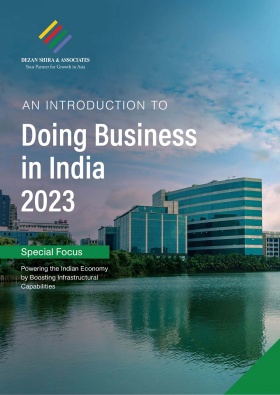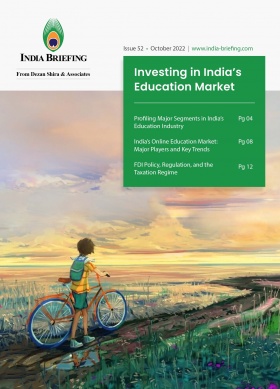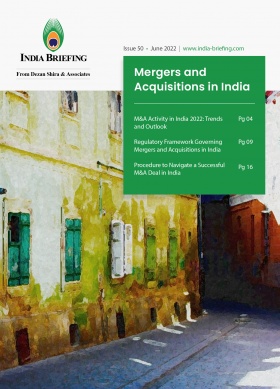India-Germany Two-Way Trade and Investment
India and Germany have a strategic partnership, with both nations maintaining close bilateral and trade ties since 2001. In 2023, the two nations signed the Work Plan 2023, focusing on global harmonization and sector-specific cooperation in artificial intelligence, cybersecurity, circular economy, and smart farming.
A recent survey reveals that nearly 60 percent of German businesses plan to increase investment in India in FY 2024–25, with 78 percent intending to boost investments over the next five years. Additionally, it has been reported that Germany plans to increase visa availability for skilled workers from India in the coming year.
This article briefly discusses the latest trade and investment trends between India and Germany.
Given the geopolitical and economic developments in the Indo-Pacific, German and European foreign policymakers view India as a pivotal partner. At present, Germany and India do not have a free trade agreement (FTA). However, there are ongoing negotiations between the European Union (EU) and India, in which Germany is keen on sealing the trade deal.
Though the FTA dialogues started in 2007, the EU-India Broad-based Trade and Investment Agreement (BTIA) negotiations have been sporadic. With the revival of FTA negotiations and Germany’s increasing business interest in India, the two countries may forge more comprehensive trade and bilateral relations in the coming years.
India and Germany trade relations
India’s trade with Germany has shown steady growth, peaking at US$24 billion in 2018-19 and remained relatively stable since then, with a marginal dip as of FY 2023-24. In 2022-23, bilateral trade increased by 4.9 percent to a value of U$26 billion, with Indian exports increasing by 2.5 percent at US$10.1 billion and imports from Germany around US$14.9 billion.
|
India Germany Import-Export Data (Value in US$ Million) |
|||
|
Trade figures |
2021-2022 |
2022-2023 |
2023-2024 |
|
India’s exports to Germany |
9,883.34 |
10,134.55 |
9,839.64 |
|
India’s imports from Germany |
14,968.10 |
16,601.53 |
16,270.35 |
|
Total |
24,851.43 |
26,736.08 |
26,109.98 |
|
Trade balance |
-5,084.76 |
-6,466.98 |
-6,430.71 |
Source: Ministry of Commerce and Industry
Key Indian exports to Germany include electrical products, automobiles and auto components, textiles and garments, chemicals, pharmaceuticals, metal products, food and beverages, tobacco, and leather goods. Major German exports to India consist of machinery, automobiles and auto components, chemicals, data processing equipment, and electric equipment.
|
India’s Exports to Germany (Value in US$ Million) |
|||
|
Commodities |
2022-23 |
2023-24 |
Growth (in %) |
|
Nuclear reactors, boilers, machinery and mechanical appliances; parts thereof. |
1,480.11 |
1,519.19 |
2.64 |
|
Electrical machinery and equipment and parts thereof; sound recorders and reproducers, television image and sound recorders and reproducers, and parts. |
1,223.34 |
1,238.86 |
1.27 |
|
Electrical machinery and equipment and parts thereof; sound recorders and reproducers, television image and sound recorders and reproducers, and parts. |
1,223.34 |
1,238.86 |
1.27 |
|
Vehicles other than railway or tramway rolling stock, and parts and accessories thereof. |
506.08 |
623.91 |
23.28 |
|
Pharmaceutical products |
297.15 |
352.24 |
18.54 |
|
Inorganic chemicals; organic or inorganic compounds of precious metals, of rare-earth metals, or radi. Elem. Or of isotopes. |
62.83 |
57.47 |
-8.54 |
|
Tobacco and manufactured tobacco substitutes. |
11.54 |
13.48 |
16.76 |
|
Cereals. |
17.62 |
32.85 |
86.39 |
|
Edible vegetables and certain roots and tubers. |
30.82 |
32.68 |
6.04 |
|
Articles of leather, saddlery and harness; travel goods, handbags and similar content |
304.73 |
271.06 |
-11.05 |
|
Iron and steel |
200.27 |
219.55 |
9.62 |
Source: Ministry of Commerce and Industry
|
Germany’s Exports to India (Value in US$ Million) |
|||
|
Commodities |
2022-23 |
2023-24 |
Growth (in %) |
|
Inorganic chemicals; organic or inorganic compounds of precious metals, of rare-earth metals. |
153.39 |
116.08 |
-24.32 |
|
Organic chemicals |
340.13 |
396.84 |
16.67 |
|
Miscellaneous chemical products. |
435.44 |
441.85 |
1.47 |
|
Nuclear reactors, boilers, machinery and mechanical appliances; parts thereof. |
4,340.78 |
4,861.83 |
12.00 |
|
Electrical machinery and equipment and parts thereof; sound recorders and reproducers, television image and sound recorders and reproducers, and parts. |
1,845.17 |
2,109.10 |
14.30 |
|
Plastic and articles thereof. |
699.52 |
614.43 |
-12.16 |
|
Paper and paperboard; articles of paper pulp, of paper or of paperboard. |
121.14 |
114.97 |
-5.09 |
|
Vehicles other than railway or tramway rolling stock, and parts and accessories thereof. |
1,024.86 |
1,174.92 |
14.64 |
|
Aircraft, spacecraft, and parts thereof. |
2,403.14 |
1,433.58 |
-40.35 |
|
Rubber and articles thereof. |
185.01 |
180.83 |
-2.26 |
Source: Ministry of Commerce and Industry
India-Germany bilateral relations
Key bilateral agreements between India and Germany include the Agreement on Avoidance of Double Taxation (DTAA), effective since 1996, and the Comprehensive Agreement on Social Security, in force since May 2017.
There are multiple Joint Working Groups (JWGs) between the two countries across various sectors, including agriculture, automotive, energy, coal, tourism, vocational education, standardization/product safety, environment, water and waste management, urban development, climate change, health, traditional medicine, biodiversity, and railways.
During the 6th IGC in Berlin in 2022, a Joint Declaration of Intent (JDI) on the ‘Indo-German Green Hydrogen Task Force’ was signed between Germany’s Ministry for Economic Affairs and Climate Action (BMWK) and India’s Ministry of New and Renewable Energy (MNRE) to enhance cooperation in green hydrogen production, utilization, storage, and distribution. India signed several government-to-government agreements with Germany focusing on green and sustainable development.
India and Germany also collaborate in agriculture, artificial intelligence, digital technologies, urban mobility, sustainable development, and startup interactions. India is scheduled to host the Asia Pacific Conference of German Business in October 2024.
India-Germany diplomatic and strategic interactions
Relations between India and Germany can also be analyzed by frequent high-level interactions. On June 15, 2024, Indian Prime Minister Narendra Modi and German Chancellor Olaf Scholz met during the G7 Summit in Rome. They reviewed progress in their Strategic Partnership and discussed enhancing cooperation in defense, sustainable development, critical minerals, skilled personnel mobility, and education, according to a press release from the Indian Ministry of External Affairs (MEA).
Prior to this, the two leaders had met during the New Delhi G20 Summit in September 2023.
In February 2023, during a meeting in New Delhi, Prime Minister Modi and Chancellor Scholz agreed to develop a roadmap for innovation and technology to leverage scientific and technological knowledge for economic development and tackle global challenges. The vision document on enhancing cooperation in technology and innovation outlined the following focus areas:
- Energy partnership and clean technologies, including green hydrogen
- Strengthening the framework and ecosystem for Indo-German business relations
- Digital technologies, including fintech
- Artificial intelligence (AI)
- 5G/6G
While Prime Minister Modi noted that Germany is India’s largest trading partner in Europe and a significant source of investment for the country, German Chancellor Scholz noted that around 1,800 German companies operate in India, creating thousands of jobs, and emphasized Germany’s interest in benefiting from Indian talent.
Germany’s FDI into India
As of FY2023-24, Germany is the 9th largest foreign direct investor in India with a cumulative FDI in India of US$505 million. From April 2000 to March 2024, the country has made total investments of US$14,643 million in India.
German investments in India primarily focus on the following sectors: transportation, electrical equipment, metallurgical industries, the services sector (especially insurance), chemicals, construction, trading, and automobiles.
Top German companies in India
- Zydus Cadila
- German Express Shipping Agency (India) Pvt Ltd.
- GermanSolar
- AUMA India Private Limited (German MNC)
- Mercedes-Benz India
- Indo-German Chamber of Commerce
- Dansden Consulting Pvt. Ltd.
- Truetzschler India Private Limited
- METZ India
- Arthur’s Food Company Pvt. Ltd.
- IAV India Pvt Ltd
- Allianz
- BASF India
- Bosch Group
- Deutsche Bank
- Siemens
The German Mittelstand (SME) companies, which make up over 90 percent of Germany’s manufacturing sector, are considered the backbone of the German economy. The German Embassy’s Make in India Mittelstand (MIIM) Program supports high-potential Mittelstand companies with medium to long-term potential for manufacturing in India, facilitating their market entry. Currently, 174 companies are participating in the MIIM program, with declared investments exceeding €1.5 billion.
Indian investments in Germany have also increased in recent years, particularly in value chain activities, such as local manufacturing of goods and services and engaging in R&D activities, in addition to trading. Over 215 Indian companies operate in Germany – in IT, automotives, pharmaceuticals, biotech, and manufacturing sectors.
Top 10 Indian companies in Germany
- Infosys
- HCL Technologies
- Novelis
- Aditya Birla Chemicals
- Birla Carbon
- Mahindra Group
- Dr Reddy’s
- Mindtree
- KPIT Technologies
- Zensar Technologies
Germany keen on expanding skilled visa program to attract Indian talent
While countries like Australia, Canada, and the U.S. are implementing stricter visa policies for foreign workers, Germany is moving in the opposite direction, planning to significantly increase skilled worker visas for Indian nationals. This development is encouraging news for Indians, who already make up Germany’s largest foreign demographic among students and professionals.
According to a recent media report, as of February 2024, around 130,000 Indians were employed in Germany, contributing to social security, with 44,000 being women. Many Indian professionals hold advanced degrees, with 16 percent working at specialist levels and 37 percent in expert roles. Due to their qualifications and employment in high-demand fields, Indian nationals earn an average of 41 percent more than Germany’s median full-time salary.
On October 25, 2024, German Chancellor Olaf Scholz announced an expansion of skilled work visas for Indians, increasing the quota from 20,000 to 90,000. Germany is grappling with historic labor shortages, especially as its working population ages, leaving critical vacancies in fields like the skilled trades. The German government has responded with initiatives to simplify foreign worker recruitment, recognize overseas qualifications, and enhance training opportunities. Additionally, Germany has been actively working on reducing visa wait times for applicants from India.
Germany’s growing business interest in India
India is drawing increasing interest from German businesses. As per a recently released survey report, namely “German Indian Business Outlook 2024,” nearly 60 percent of German firms based in the country are planning to boost their investments in India during this financial year. The survey, conducted by KPMG in Germany and the Indo-German Chamber of Commerce (AHK India) between April 9 and May 20, 2024, reveals the optimistic business expectations of German companies in India.
A total of 85 companies participated in the survey, of which respondents in the automotive sector accounted for 25 percent, 23 percent from industrial manufacturing, and 13 percent from professional services. The other surveyed sectors include telecommunication and media, chemicals, pharmaceuticals and healthcare, financial services, construction and infrastructure, transportation and logistics, consumer goods and retail.
The survey highlights India’s growing significance, with 59 percent of companies planning to expand investments this year, a 23 percent increase since 2021. Over the next five years, 78 percent aim to boost investments, while only 7 percent consider reducing them in 2024. Analysts believe that German companies are diversifying globally and see India as a prime location due to its large population, political stability, and sustainable growth prospects.
Digitization and AI potential area of investments
The findings note that out of almost two-thirds of the companies surveyed, approximately 63 percent believed the digitization of internal processes to be the most important technology field of investments in India in 2024. However, its significance is likely to gradually decrease by 2029.
Around 32 percent of the surveyed companies believe that future technologies such as artificial intelligence (AI), algorithms, and machine learning (ML) represent bright investment opportunities in the long term.
Although just 8 percent of respondents believe that investing in technologies like augmented reality (AR), virtual reality (VR), extended reality, and the metaverse is significant presently, by 2029 more businesses are likely to be interested in these innovations.
Key factors attracting German investment in India
The top three factors attracting German companies to India are low labor costs (54 percent), political stability (53 percent), and the availability of qualified specialists (47 percent)– up 12 percent from the previous year. However, companies expect labor cost advantages to diminish by 2029, with only 36 percent still foreseeing benefits. Compared to other Asian countries, 69 percent of German businesses value India’s steady economic growth, especially as China’s economy weakens.
Currently, 33 percent of German companies reportedly use India as a production base for the local market, a figure expected to rise to 45 percent by 2029. For 27 percent of German companies, India’s vast consumer market of over 1.44 billion people is a key attraction, with 40 percent prioritizing this by 2029. Furthermore, India’s role as a global competence or shared service center is increasingly crucial, with 21 percent of companies having established such centers and 35 percent planning to do so within five years.
About Us
India Briefing is one of five regional publications under the Asia Briefing brand. It is supported by Dezan Shira & Associates, a pan-Asia, multi-disciplinary professional services firm that assists foreign investors throughout Asia, including through offices in Delhi, Mumbai, and Bengaluru in India. Readers may write to india@dezshira.com for support on doing business in India. For a complimentary subscription to India Briefing’s content products, please click here.
Dezan Shira & Associates also maintains offices or has alliance partners assisting foreign investors in China, Hong Kong SAR, Dubai (UAE), Indonesia, Singapore, Vietnam, Philippines, Malaysia, Thailand, Bangladesh, Italy, Germany, the United States, and Australia.
(This article was originally published on January 23, 2023, and last updated on November 14, 2024.)
- Previous Article Perfil de comercio e inversión bilateral entre India y España
- Next Article Managing Financial Risks: A How-to Guide for Businesses in India








